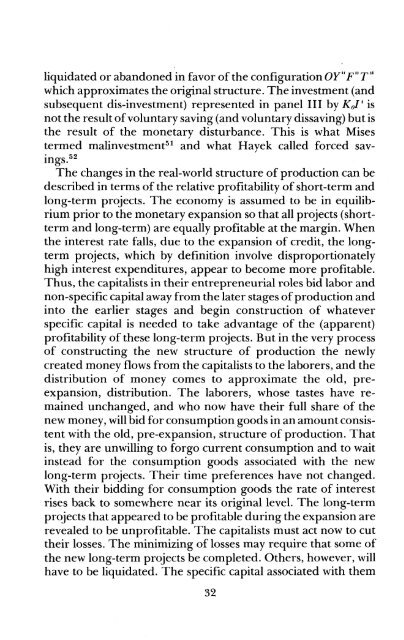Austrian Macroeconomics - Ludwig von Mises Institute
Austrian Macroeconomics - Ludwig von Mises Institute
Austrian Macroeconomics - Ludwig von Mises Institute
You also want an ePaper? Increase the reach of your titles
YUMPU automatically turns print PDFs into web optimized ePapers that Google loves.
liquidated or abandoned in favor ofthe configuration Oy"F II<br />
T II<br />
which approximates the original structure. The investment (and<br />
subsequent dis-investment) represented in panel III by Kol' is<br />
not the result ofvoluntary saving (and voluntary dissaving) but is<br />
the result of the monetary disturbance. This is what <strong>Mises</strong><br />
termed malinvestment51 and what Hayek called forced savings.<br />
52<br />
The changes in the real-world structure of production can be<br />
described in terms ofthe relative profitability ofshort-term and<br />
long-term projects. The economy is assumed· to be in equilibrium<br />
prior to the monetary expansion so that all projects (shortterm<br />
and long-term) are equally profitable at the margin. When<br />
the interest rate falls, due to the expansion of credit, the longterm<br />
projects, which by definition involve disproportionately<br />
high interest expenditures, appear to become more profitable.<br />
Thus, the capitalists in their entrepreneurial roles bid labor and<br />
non-specific capital away from the later stages ofproduction and<br />
into the earlier stages and begin construction of whatever<br />
specific capital is needed to take advantage of the (apparent)<br />
profitability of these long-term projects. But in the very process<br />
of constructing the new structure of production the newly<br />
created money flows from the capitalists to the· laborers, and the<br />
distribution of money comes to approximate the old, preexpansion,<br />
distribution. The laborers, whose tastes have remained<br />
unchanged, and who now have their full share of the<br />
new money, will bid for consumption goods in an amount consistent<br />
with the old, pre-expansion, structure of production. That<br />
is, they are unwilling to forgo current consumption and to wait<br />
instead for the consumption goods associated with the new<br />
long-term projects. Their time preferences have not changed.<br />
With their bidding for consumption goods the rate of interest<br />
rises back to somewhere near its original level. The long-term<br />
projects that appeared to be profitable during the expansion are<br />
revealed to be unprofitable. The capitalists must act now to cut<br />
their losses. The minimizing of losses may require that some of<br />
the new long-term projects be completed. Others, however, will<br />
have to be liquidated. The specific capital associated with them<br />
32

















